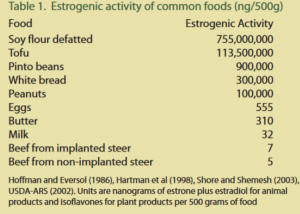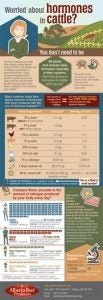There are many questions, myths, and misconceptions about hormones in meat and milk. Among them: Are hormones used in food animals? Why are they used? Are meat and dairy products safe?
I’m going to explore this topic and address these questions.
Hormones are chemical messengers that signal processes in the body, whether they’re an animal, plant, or human. All of us produce hormones.
These chemical messengers are only received by the intended target cells and tissues with the specific receptor for that particular hormone. Think of it like a mass email that is only received by people on the email list. Cells without the particular receptor can’t bind the particular hormones and thus ignore its signal.
Hormones exist in three major classes on the basis of chemical structure. And there are differences between hormones and steroids. Steroids still act as messengers and have effects when taken orally, like human birth control pills. Protein hormones on the other hand are broken down and lose their ability to have any effects when ingested. Growth hormones are proteins and, similar to insulin for diabetics, cannot be taken orally, because they lose their effects.
All naturally occurring foods contain hormones, including plants! So, technically there is no such thing as “hormone-free” foods of any sort. That is simply deceptive marketing.
So what happens to the hormones we eat? According to a study published in the Journal of Nutrition, hormones found in dairy and beef are digested in the stomach and not passed into the bloodstream. This means these foods do not affect our own hormone production, and we should be aware that residues or hormones have little to no impact on human biology.
While hormones are naturally occurring in living things and thus low-levels of hormones can be found in meat and dairy, there’s actually more estrogen in soy flour or tofu than milk or beef — by a long shot!

What about added hormone use? What farm animal species in the U.S. use them and why?
Beef? You’ll notice in the above chart that there is a slight difference in estrogen in beef from an implanted steer versus a non-implanted steer. This is only 2 nanograms, which is two billionths of a gram. An adult female produces 480,000 mg of estrogen per day, which is 95.3 cows’ worth of beef from an animal with hormone implants! For an adult male that’s 136,000 ng per day or 27 cows’ worth!
Growth hormone use is allowed in beef cattle to help the animal more efficiently convert feed to muscle. They need less feed to gain the same amount of weight. This means fewer resources are needed to produce the same amount of beef, which leads to a smaller environmental footprint and more affordable beef.
“Small alterations in hormones can have impacts on the function of the animal (e.g. they grow more efficiently) without leading to significant impacts in the concentrations of hormones in the animal’s muscle and other tissues,” explained Dr. Sara Place, associate professor at Colorado State University’s College of Agricultural Sciences.
Implants are a small slow-release pellet inserted under the skin of the animal’s ear. Growth hormones have no effects if ingested, because they’re proteins and broken down just like any other protein. The ear with the implant is also discarded post-harvest. Eating beef from a steer that had an implant does not have any significant effect on your hormones.
“Hormones send a signal — a specific one that in the case of implants leads to improved growth for every pound of feed the animal consumes. But the signal doesn’t necessarily stick around,” Place said.

How about poultry or pork? All chickens, turkeys, and pigs raised and sold in the U.S. are free from added growth hormones.
The U.S. Department of Agriculture banned the use of hormones and steroids in poultry in the 1950s. Poultry nowadays grow faster and more efficiently due to advances in traditional breeding methods, nutrition, veterinary care, and living conditions that lead to healthier birds. It’s all about slow and steady improvements in genetics, nutrition, management, and biosecurity.
There would also be high costs involved in administering hormones to poultry, as growth hormones cannot be effectively fed to poultry, and labor difficulties are apparent when administering individually to millions of birds. All to say, there’s no scientific, economic, or legal sense for farmers to use hormones in poultry production.
Similar things can be said for pigs. Hormones are not needed, because of these consistent improvements in animal care, which leads to improved profitability.
What about hormones in dairy/milk? If you’ve ever examined the label on your gallon of milk, you may have seen something along the lines of “raised without artificial hormones” or something to that effect. If you look very closely, you’ll see an asterisk that leads to some tiny print that says “the FDA has stated that there is no significant difference between milk from rBST treated and untreated cows.” BST (bovine somatotropin) is a protein hormone that cows naturally produce, which is important in growth, development, and milk production. rBST is the man-made version of BST, which is chemically the same. As a protein hormone, it is broken down when ingested and becomes inactive. The FDA approved rBST’s use in 1993.
» Related: Holstein steers given hormone implants grow as well as beef steers
Researchers as early as the 1930s and 1940s found that giving milk-producing cows rBST can help maintain consistent milk production levels. It can also increase feed efficiency 2.7 percent to 9.3 percent. However, to see much gain from its use, cows must be well cared for. Healthy cows can produce more, high-quality milk. Although this technology would increase feed to milk efficiency, it is hardly ever used on U.S. dairy farms due to consumer perceptions and subsequent marketing.
Next time you see the label “hormone free” on your gallon of milk, or a package of chicken “raised with no added hormones,” you’ll know that “hormone free” food is just a marketing gimmick, and that all chicken is raised without added hormones.
Michelle Miller, the “Farm Babe,” is an internationally recognized keynote speaker, writer, and social media influencer and travels full time to advocate for agriculture. She comes from an Iowa-based row crop and livestock farming background and now resides on a timber farm in North Central Florida.



